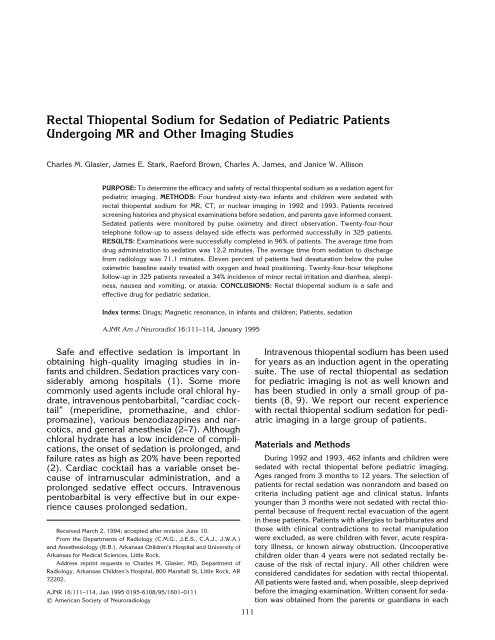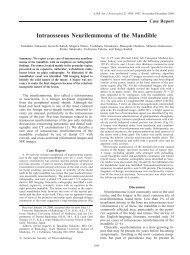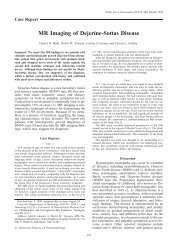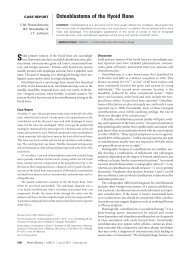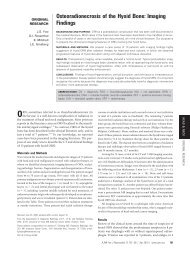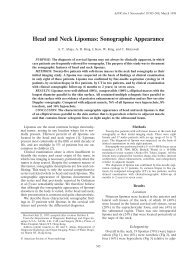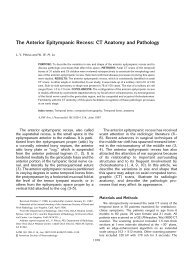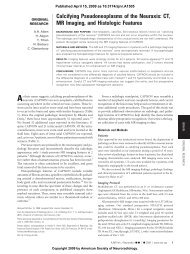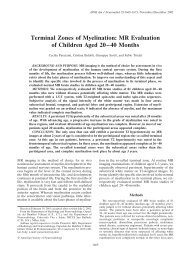Rectal Thiopental Sodium for Sedation of Pediatric Patients ...
Rectal Thiopental Sodium for Sedation of Pediatric Patients ...
Rectal Thiopental Sodium for Sedation of Pediatric Patients ...
You also want an ePaper? Increase the reach of your titles
YUMPU automatically turns print PDFs into web optimized ePapers that Google loves.
<strong>Rectal</strong> <strong>Thiopental</strong> <strong>Sodium</strong> <strong>for</strong> <strong>Sedation</strong> <strong>of</strong> <strong>Pediatric</strong> <strong>Patients</strong><br />
Undergoing MR and Other Imaging Studies<br />
Charles M. Glasier, James E. Stark, Rae<strong>for</strong>d Brown, Charles A. James, and Janice W. Allison<br />
PURPOSE: To determine the efficacy and safety <strong>of</strong> rectal thiopental sodium as a sedation agent <strong>for</strong><br />
pediatric imaging. METHODS: Four hundred sixty-two infants and children were sedated with<br />
rectal thiopental sodium <strong>for</strong> MR, CT, or nuclear imaging in 1992 and 1993. <strong>Patients</strong> received<br />
screening histories and physical examinations be<strong>for</strong>e sedation, and parents gave in<strong>for</strong>med consent.<br />
Sedated patients were monitored by pulse oximetry and direct observation. Twenty-four-hour<br />
telephone follow-up to assess delayed side effects was per<strong>for</strong>med successfully in 325 patients.<br />
RESULTS: Examinations were successfully completed in 96% <strong>of</strong> patients. The average time from<br />
drug administration to sedation was 12.2 minutes. The average time from sedation to discharge<br />
from radiology was 71.1 minutes. Eleven percent <strong>of</strong> patients had desaturation below the pulse<br />
oximetric baseline easily treated with oxygen and head positioning. Twenty-four-hour telephone<br />
follow-up in 325 patients revealed a 34% incidence <strong>of</strong> minor rectal irritation and diarrhea, sleepiness,<br />
nausea and vomiting, or ataxia. CONCLUSIONS: <strong>Rectal</strong> thiopental sodium is a safe and<br />
effective drug <strong>for</strong> pediatric sedation.<br />
Index terms: Drugs; Magnetic resonance, in infants and children; <strong>Patients</strong>, sedation<br />
AJNR Am J Neuroradiol 16:111–114, January 1995<br />
Safe and effective sedation is important in<br />
obtaining high-quality imaging studies in infants<br />
and children. <strong>Sedation</strong> practices vary considerably<br />
among hospitals (1). Some more<br />
commonly used agents include oral chloral hydrate,<br />
intravenous pentobarbital, “cardiac cocktail”<br />
(meperidine, promethazine, and chlorpromazine),<br />
various benzodiazapines and narcotics,<br />
and general anesthesia (2–7). Although<br />
chloral hydrate has a low incidence <strong>of</strong> complications,<br />
the onset <strong>of</strong> sedation is prolonged, and<br />
failure rates as high as 20% have been reported<br />
(2). Cardiac cocktail has a variable onset because<br />
<strong>of</strong> intramuscular administration, and a<br />
prolonged sedative effect occurs. Intravenous<br />
pentobarbital is very effective but in our experience<br />
causes prolonged sedation.<br />
Received March 2, 1994; accepted after revision June 10.<br />
From the Departments <strong>of</strong> Radiology (C.M.G., J.E.S., C.A.J., J.W.A.)<br />
and Anesthesiology (R.B.), Arkansas Children’s Hospital and University <strong>of</strong><br />
Arkansas <strong>for</strong> Medical Sciences, Little Rock.<br />
Address reprint requests to Charles M. Glasier, MD, Department <strong>of</strong><br />
Radiology, Arkansas Children’s Hospital, 800 Marshall St, Little Rock, AR<br />
72202.<br />
AJNR 16:111–114, Jan 1995 0195-6108/95/1601–0111<br />
American Society <strong>of</strong> Neuroradiology<br />
Intravenous thiopental sodium has been used<br />
<strong>for</strong> years as an induction agent in the operating<br />
suite. The use <strong>of</strong> rectal thiopental as sedation<br />
<strong>for</strong> pediatric imaging is not as well known and<br />
has been studied in only a small group <strong>of</strong> patients<br />
(8, 9). We report our recent experience<br />
with rectal thiopental sodium sedation <strong>for</strong> pediatric<br />
imaging in a large group <strong>of</strong> patients.<br />
Materials and Methods<br />
During 1992 and 1993, 462 infants and children were<br />
sedated with rectal thiopental be<strong>for</strong>e pediatric imaging.<br />
Ages ranged from 3 months to 12 years. The selection <strong>of</strong><br />
patients <strong>for</strong> rectal sedation was nonrandom and based on<br />
criteria including patient age and clinical status. Infants<br />
younger than 3 months were not sedated with rectal thiopental<br />
because <strong>of</strong> frequent rectal evacuation <strong>of</strong> the agent<br />
in these patients. <strong>Patients</strong> with allergies to barbiturates and<br />
those with clinical contradictions to rectal manipulation<br />
were excluded, as were children with fever, acute respiratory<br />
illness, or known airway obstruction. Uncooperative<br />
children older than 4 years were not sedated rectally because<br />
<strong>of</strong> the risk <strong>of</strong> rectal injury. All other children were<br />
considered candidates <strong>for</strong> sedation with rectal thiopental.<br />
All patients were fasted and, when possible, sleep deprived<br />
be<strong>for</strong>e the imaging examination. Written consent <strong>for</strong> sedation<br />
was obtained from the parents or guardians in each<br />
111
112 GLASIER AJNR: 16, January 1995<br />
case. Each child had a screening history and physical<br />
examination with particular attention to airway status per<strong>for</strong>med<br />
by a radiology nurse. <strong>Thiopental</strong> sodium was administered<br />
from a prefilled calibrated syringe (Abbott Laboratories,<br />
North Chicago, Ill) by a radiology nurse. Initial<br />
dosage was 25 mg/kg into the distal rectum. A second<br />
dose <strong>of</strong> 15 mg/kg was given if the child was awake 20<br />
minutes later. No absolute total dose limit was used, although<br />
a total dose <strong>of</strong> greater than 40 mg/kg was not<br />
given. The package insert recommends that a total dose <strong>of</strong><br />
1 to 1.5 g in children weighing more than 75 lb not be<br />
exceeded. All patients were monitored with pulse oximetry<br />
and close observation by radiology nurses. Baseline pulse<br />
oximetric reading and any deviation <strong>of</strong> oxygenation from<br />
the baseline was recorded. Any drop <strong>of</strong> pulse oximetric<br />
reading from baseline was considered desaturation and<br />
treated with oxygen and head positioning if necessary.<br />
Sedated patients were not discharged from the radiology<br />
department until awake. <strong>Sedation</strong> was considered successful<br />
if the requested examination was completed without<br />
a return visit to radiology. Twenty-four hour telephone<br />
follow-up was attempted in each patient. Parents were<br />
questioned about delayed effects <strong>of</strong> rectal sedation, including<br />
rectal irritation or discharge, prolonged sleepiness,<br />
nausea or vomiting, and stumbling (ataxia). The patients<br />
who were not successfully sedated with thiopental returned<br />
<strong>for</strong> further imaging on another day, with intravenous pentobarbital<br />
<strong>for</strong> sedation.<br />
Results<br />
Four hundred sixty-two patients were sedated;<br />
445 (96%) <strong>of</strong> 462 sedations were successful,<br />
defined as adequate to complete the<br />
requested examination without the need <strong>for</strong> a<br />
return visit to the radiology department. Seventy-one<br />
(15%) <strong>of</strong> 462 patients required second<br />
doses <strong>of</strong> medication. The average time from<br />
administration <strong>of</strong> the first dose to beginning <strong>of</strong><br />
the scan was 12.2 minutes. The average time<br />
from administration <strong>of</strong> the first dose to discharge<br />
from the radiology department was 71.1<br />
minutes. Fifty-two (11%) <strong>of</strong> 462 patients had<br />
transient drops in pulse oximetric readings below<br />
the baseline values. All desaturations were<br />
successfully treated with oxygen therapy and<br />
head positioning. No patient required placement<br />
<strong>of</strong> an artificial airway or transfer from the<br />
radiology department. There were no respiratory<br />
arrests. Twenty-four-hour telephone contact<br />
was successful in 325 (70%) <strong>of</strong> 462 patients;<br />
215 (66%) <strong>of</strong> 325 parents reported no<br />
observed delayed side effects from rectal sedation;<br />
110 (34%) <strong>of</strong> 325 reported delayed side<br />
effects, including rectal irritation or discharge in<br />
64 (58%) <strong>of</strong> 110, prolonged sleepiness in 15<br />
(14%) <strong>of</strong> 110, nausea or vomiting in 17 (15%) <strong>of</strong><br />
110, and stumbling (ataxia) in 14 (13%) <strong>of</strong> 110.<br />
None <strong>of</strong> the patients with rectal discharge or<br />
irritation required visit to a physician <strong>for</strong> treatment.<br />
The other symptoms generally resolved 1<br />
to 4 hours after the examination.<br />
Discussion<br />
<strong>Sedation</strong> is frequently necessary to obtain<br />
motion-free imaging studies in children younger<br />
than 6 years <strong>of</strong> age. Although even young children<br />
may cooperate <strong>for</strong> computed tomographic<br />
scanning, the much longer scan times and more<br />
confining position required <strong>for</strong> magnetic resonance<br />
imaging increases the need <strong>for</strong> sedation.<br />
In our practice, 10% <strong>of</strong> children are sedated <strong>for</strong><br />
computed tomography, but 40% <strong>for</strong> magnetic<br />
resonance.<br />
The ideal pediatric sedative would be reversible<br />
and easy to administer, provide consistent<br />
and reliable sedation, and have minimal side<br />
effects and a rapid recovery. At the current<br />
time, no agent fulfills all these requirements.<br />
The most commonly used agent, chloral hydrate,<br />
is safe and easy to administer, but in<br />
generally accepted doses (50 to 100 mg/kg<br />
orally) in our experience has an unpredictable<br />
onset and unreliable sedative effects. Intramuscular<br />
drug administration is painful, and the onset<br />
<strong>of</strong> sedation is <strong>of</strong>ten delayed and unpredictable.<br />
Intravenous barbiturates such as<br />
pentobarbital are very effective with rapid onset,<br />
but establishing intravenous access is not always<br />
easy or well tolerated. In addition, the<br />
sedative effect <strong>of</strong> pentobarbital may linger <strong>for</strong><br />
hours, making neurologic examinations difficult<br />
in patients being imaged because <strong>of</strong> central nervous<br />
system disorders. General anesthesia is<br />
routinely used <strong>for</strong> magnetic resonance imaging<br />
in several pediatric hospitals but is expensive<br />
and, in our experience, interrupts the imaging<br />
schedule. The overall frequency <strong>of</strong> complications<br />
associated with sedation is not known, but<br />
several cases <strong>of</strong> respiratory arrest and death in<br />
sedated children have occurred (10).<br />
<strong>Thiopental</strong> sodium is a highly lipid soluble<br />
agent with a short half-life (11). The drug is<br />
metabolized in the liver. The plasma half-life is 3<br />
minutes. The drug is stored in fatty tissue, which<br />
can lead to prolonged duration <strong>of</strong> action in the<br />
case <strong>of</strong> overdosage. It is dispensed in a prefilled<br />
calibrated syringe (Fig 1) and is administered<br />
by injection into the distal rectum. Administra-
AJNR: 16, January 1995 THIOPENTAL SODIUM 113<br />
Fig 1. Graduated dispensing syringe used <strong>for</strong> administration<br />
<strong>of</strong> rectal thiopental sodium. The plastic hub lock (black arrow)<br />
helps prevent overdosage. The syringe contains 2400 mg <strong>of</strong> the<br />
drug. The hub has notches designating 100-mg increments.<br />
tion high into the rectum is ineffective because<br />
<strong>of</strong> portal drainage <strong>of</strong> the upper rectum, with<br />
rapid hepatic drug inactivation. <strong>Sedation</strong> is<br />
achieved by generalized central nervous system<br />
depression. The drug is rapidly absorbed into<br />
the systemic circulation from the distal rectum<br />
with onset <strong>of</strong> sedation in 5 to 10 minutes. Uptake<br />
is not affected by presence <strong>of</strong> stool. Most<br />
side effects are related to respiratory depression<br />
and were generally minimal and easily treated<br />
in our patients. Idiosyncratic reactions have<br />
been reported. Although not occurring during<br />
the period <strong>of</strong> this study, we have seen moderately<br />
severe respiratory depression in 2 infants<br />
sedated with rectal thiopental <strong>of</strong> approximately<br />
1400 patients sedated with this agent since<br />
1991. One <strong>of</strong> these patients was subsequently<br />
found to have marked adenoidal enlargement<br />
compromising the airway, and the other had<br />
achondroplasia with severe <strong>for</strong>amen magnum<br />
stenosis and resultant apnea. In both <strong>of</strong> these<br />
patients oxygenation dropped into the 50s after<br />
thiopental administration; they were successfully<br />
treated with oxygen and oral airway placement<br />
without tracheal intubation. The infant<br />
with large adenoids was uneventfully sedated<br />
and imaged with thiopental sedation after<br />
adenoidectomy. The infant with achondroplasia<br />
was subsequently imaged under general<br />
anesthesia.<br />
Because repeat dosage can lead to accumulation<br />
<strong>of</strong> the drug in fatty tissues, a total dosage<br />
<strong>of</strong> about 40 mg/kg is not exceeded in our practice.<br />
The package insert recommends a total<br />
dose no greater than 1 to 1.5 g in patients<br />
weighing more than 75 lb. The mild rectal irritation<br />
and diarrhea apparently related to rectal<br />
thiopental administration were generally acceptable<br />
to parents and to referring physicians.<br />
We avoid rectal drug administration in patients<br />
with known or suspected rectal trauma and in<br />
patients with severe thrombocytopenia. Infants<br />
younger than 3 months were not sedated with<br />
rectal thiopental because they tend to expel the<br />
drug from the rectum. The importance <strong>of</strong> proper<br />
sedation techniques cannot be overemphasized<br />
(12, 13). Trained personnel are essential. A<br />
complete “crash cart” as well as suction and<br />
oxygen equipment must be available in the immediate<br />
imaging area. A directed, current history<br />
and physical examination should screen <strong>for</strong><br />
conditions that might affect airway status or<br />
cardiopulmonary reserve. Medication history<br />
may reveal possible drug interactions. Back-up<br />
emergency assistance must be available. Mechanical<br />
monitoring should include at least continuous<br />
pulse oximetry, although continuous<br />
electrocardiography, blood pressure, and capnography<br />
would be optimal (14). Finally and<br />
most importantly, one trained person not involved<br />
in scanning should continuously observe<br />
the patient (or the monitor when the child is out<br />
<strong>of</strong> sight in the bore <strong>of</strong> a magnet).<br />
Parents and young children are <strong>of</strong>ten familiar<br />
with rectal administration <strong>of</strong> medication and<br />
with rectal insertion <strong>of</strong> a thermometer and <strong>of</strong>ten<br />
find rectal sedation less threatening than the<br />
intravenous route. The successful use <strong>of</strong> another<br />
short-acting barbiturate, methohexital, <strong>for</strong><br />
pediatric sedation has been previously reported<br />
(15). Those authors, however, reported a lower<br />
incidence <strong>of</strong> effective sedation than that found<br />
with thiopental in our series, particularly <strong>for</strong><br />
magnetic resonance imaging. In addition, our<br />
ordering clinicians, particularly neurosurgeons,<br />
neurologists, and emergency physicians who<br />
per<strong>for</strong>m neurologic examinations on these patients<br />
shortly after imaging studies are per<strong>for</strong>med,<br />
prefer rectal thiopental sedation to<br />
intravenous pentobarbital because <strong>of</strong> the relatively<br />
brief period <strong>of</strong> central nervous system<br />
depression seen with thiopental sedation.<br />
In this series <strong>of</strong> 462 infants and children undergoing<br />
sedation with rectal thiopental, onset<br />
<strong>of</strong> sedation was rapid, averaging 12 minutes<br />
from drug administration to beginning <strong>of</strong> scanning.<br />
<strong>Sedation</strong> was successful in 96% <strong>of</strong> seda-
114 GLASIER AJNR: 16, January 1995<br />
tions, and patients were ready <strong>for</strong> discharge<br />
from radiology on average 71 minutes after<br />
drug administration. The incidence <strong>of</strong> both<br />
acute and delayed side effects is acceptable to<br />
us, our referring clinicians, and the parents. In<br />
our experience, parents whose children have<br />
been successfully sedated with both intravenous<br />
agents and rectal thiopental almost universally<br />
request rectal sedation.<br />
The ideal sedative drug <strong>for</strong> pediatric imaging<br />
with a high degree <strong>of</strong> efficacy and lack <strong>of</strong> significant<br />
side effects is not yet available. <strong>Rectal</strong><br />
thiopental sodium has become the most commonly<br />
used sedative agent in our department<br />
over the last several years in patients older than<br />
2 months <strong>of</strong> age because <strong>of</strong> the ease <strong>of</strong> administration,<br />
reliably rapid onset <strong>of</strong> sedation, safety,<br />
and patient and parent acceptance.<br />
References<br />
1. Keeter S, Benator RM, Weinberg SM, Hartenberg MA. <strong>Sedation</strong> in<br />
pediatric CT: national survey <strong>of</strong> current practice. Radiology 1990;<br />
175:745–752<br />
2. Nahata MC. <strong>Sedation</strong> in pediatric patients undergoing diagnostic<br />
procedures. Drug Intell Clin Pharm 1988;22:711–715<br />
3. Temme JB, Anderson JC, Matecko S. <strong>Sedation</strong> <strong>of</strong> children <strong>for</strong> CT<br />
and MRI scanning. Radiol Technol 1990;61:283–285<br />
4. Cohen MD. <strong>Pediatric</strong> sedation. Radiology 1990;175:611–612<br />
5. Strain JD, Harvey LA, Foley LC, Cambell JB. Intravenously administered<br />
pentobarbital sodium <strong>for</strong> sedation in pediatric CT.<br />
Radiology 1986;161:105–108<br />
6. Thompson JR, Schneider S, Ashwal S, Holden BS, Hinshaw DB Jr,<br />
Hasso AN. The choice <strong>of</strong> sedation <strong>for</strong> computed tomography in<br />
children: a prospective evaluation. Radiology 1982;143:475–479<br />
7. Strain JD, Campbell JB, Harvey LA, Foley LC. IV Nembutal: safe<br />
sedation <strong>for</strong> children undergoing CT. AJNR Am J Neuroradiol<br />
1988;9:955–959<br />
8. White TJ III, Siegle RL, Burckart GJ, Ramey DR. <strong>Rectal</strong> thiopental<br />
<strong>for</strong> sedation <strong>of</strong> children <strong>for</strong> computed tomography. J Comput<br />
Assist Tomogr 1979;3:286–288<br />
9. Burckart GJ, White TJ III, Siegle RL, Jabbour JT, Ramey DR.<br />
<strong>Rectal</strong> thiopental versus an intramuscular cocktail <strong>for</strong> sedating<br />
children be<strong>for</strong>e computerized tomography. Am J Hosp Pharm<br />
1980;37:222–224<br />
10. Loudin A. Routine exam leads to death. RT Image 1991;4:23–25<br />
11. Goodman LS, Gilman A, Gilman AG. Barbituates. In: The Pharmacological<br />
Basis <strong>of</strong> Therapeutics. New York: Pergamon Press,<br />
1990:301–330<br />
12. Committee on Drugs. Guidlines <strong>for</strong> monitoring and management<br />
<strong>of</strong> pediatric patients during and after sedation <strong>for</strong> diagnostic and<br />
therapeutic procedures. <strong>Pediatric</strong>s 1992;89:1110–1115<br />
13. Kaufman RA. Technical aspects <strong>of</strong> abdominal CT in infants and<br />
children. AJR Am J Roentgenol 1989;153:549–554<br />
14. Council on Scientific Affairs, AMA. The use <strong>of</strong> pulse oximetry<br />
during conscious sedation. JAMA 1993;270:1463–1468<br />
15. Manuli MA, Davies L. <strong>Rectal</strong> methohexital <strong>for</strong> sedation <strong>of</strong> children<br />
during imaging procedures. AJR Am J Roentgenol 1993;160:<br />
577–580


